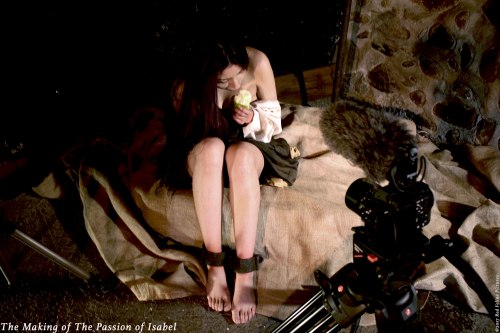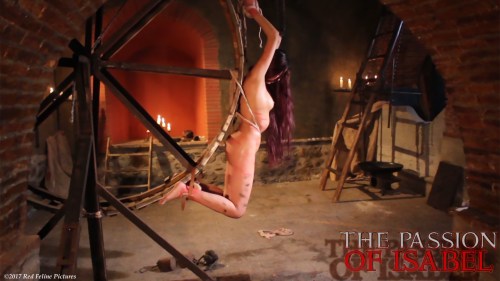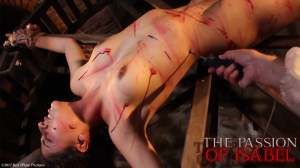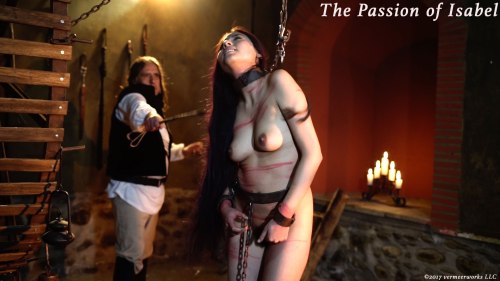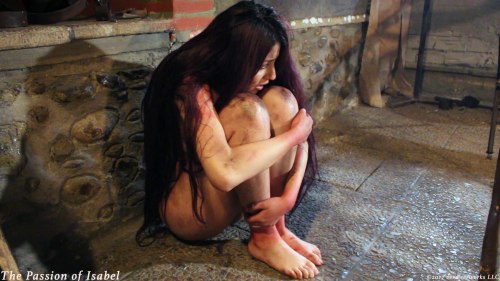by Rich Moreland, November 2017
This is the second part of my review of The Passion of Isabel, a Red Feline film starring Beatriz Rivera as the victim and Jac Avila as her torturer, Torquemada.
* * *
The Passion of Isabel sticks with its erotic theme throughout.
No Escape
For instance, food is important imagery. Torquemada teases Isabel with water to replenish her energy and eventually brings her rudimentary nourishment after he has kept her confined for two days. She’s offered an apple and a small loaf of bread, both highly sexualized symbols.
Eating is a Freudian symbol for sex. Isabel is capitulating to his sexual control over her. When he tempts her with the apple in an Adam and Eve reversal, Isabel looks into his eyes with submission in hers.
Torquemada leaves the apple so she can feed herself in an act that implies dependence and obedience. He controls his prisoner totally now and wants her strong enough to endure the abuse she will suffer. Taking the food from Isabel, Torquemada stands her up for the first round of punishment, the exquisite whipping scene mentioned in Part One of this review.
Other symbols enhance Isabel’s enslavement. During her second rape, Torquemada chokes her with the chains that keep her under his control. In BDSM play, restricting breathing during sex increases its orgasmic intensity for the masochist.
Is Isabel being taught to perversely enjoy her trials?
Another prominent image is the metallic collar which is prominent throughout the film before it is locked around Isabel’s neck. When it is on the floor on its side, the camera shoots the scene through it, framing the device with a double meaning. It represents Isabel’s manacles and its round opening is a clear statement that this is a highly sexualized film.
As a foreboding of her death, Torquemada hangs Isabel in another erotic act. He stretches out her neck with the chain attached to the collar, once again suppressing her breathing and intensifying her sexual experience as he takes control of her soul.
Notice the other circular object, the pressure belt, is secured around her waist and also acts as a metaphor for the female sex. Isabel’s youthful beauty is slowly strangling her as the collar and the belt act as opposing forces.
There is no escape. She suffers because she is desired.
Rack and Wheel
A ladder becomes a rack to stretch Isabel’s body in the proper manner prescribed by the Inquisition. As Isabel’s misery continues, close-ups of her face underscore looks of desperation and defeat.
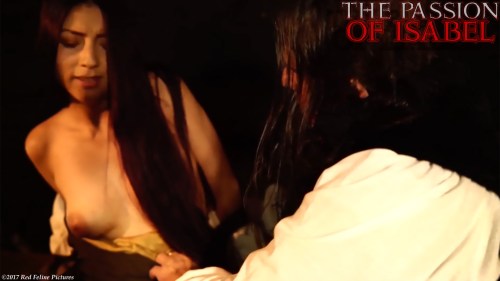 Her whimpering increases as the intensity of her trials is ratcheted up, but she never screams or cries out. Even as the end nears, Isabel displays a fortitude that is commendable.
Her whimpering increases as the intensity of her trials is ratcheted up, but she never screams or cries out. Even as the end nears, Isabel displays a fortitude that is commendable.
When the film returns to the circle motif, the scenes move to the breaking wheel, sometimes called the Catherine Wheel. Isabel’s whippings continue and to increase her humiliation, Torquemada confines her in two ways: on the rim of the wheel with her back arched and then spread-eagle on the spokes in a crucifixion position.
Beatriz Rivera deserves high praise when she is stretched on the rim. Because the weight of her body pulls her down, she is steadied by the rope around her upper body and between her legs (sensationally erotic since she is nude) while the camera captures her pain.
Though accustomed to acrobatic maneuvers to show the sex they are having, only top of the line adult actresses ever deal with such an unnatural position.
Torquemada asks, “Do you repent for your father’s death?”
Isabel remains defiant, smiling slightly and shaking her head with a “no, no.”
There’s more lashing, rape, and anguish before the film’s denouement.
Allegory
In the final crucifixion, Isabel is subjected to probes with sharp objects (the medieval test for witches) and the pressure belt to add to her torment. Torquemada nails her feet and hands and rotates the wheel so that Isabel goes from the upright Christ position to the upside-down configuration of St. Peter.
When the crown of thorns is placed on her head, there are two single branches pointing upward resembling the horns of Satan. It’s a comment that Isabel’s tribulations symbolize the fight against evil that reaches into eternity. Pay close attention when her eyes look upward.
Isabel’s stoicism soars to its heavenly heights at this point. Rightly or wrongly, she accepts the responsibility for the crime she stands accused of committing and understands her punishment.
One more observation is worthy of comment. The ball attached to the pressure belt is allegorical. The pre-Christain Atlas bears the weight of the world just as Christ takes on the sins of man.
Isabel has clearly moved from sinner to saint and as the film closes. A heartbeat is all we hear. It slows, becoming almost imperceptible into eternity with the message that death is a state of mind rather than a spiritual end.
Bea’s Triumph
In the first part of this review, I suggested that Beatriz Rivera learned her craft in the film Justine and has now matured into an artistic performer in The Passion of Isabel.
This juxtaposition of a sixteenth century story in a twenty-first century film is evident in Bea’s performance. First, she rises to fame as an erotic actress. Notice, however, that she parts with Amy Hesketh and Mila Joya when she trims and partially shaves her pubic area so the female sex is on-screen. She lets us know she’s a modern bondage star and a woman making her own statement of sexual liberation.
What’s more, the decision to leave in the stud in her nose and her single ear piercing establishes a contemporary identity. Throw in her tattoos that are only lightly covered with make-up (the one high on her back is not) and we have the kind of presentation that excites today’s BDSM aficionados.
What of Bea’s acting? As mentioned in part one, her range of expressions are largely non-verbal which requires concentration and awareness of what the scene is asking of her. She is subtle in her message of suffering.
Not only that, but her whipping scenes are realistic. At no time does she appear as a caricature of a victim. The viewer can feel her pain and the lingering agony of her relentless torture.
For these reasons which move Beatriz Rivera as actress beyond her lovely nakedness, Red Feline fans are going to demand more from this Bolivian sweetheart. Her film presence is pure erotic pleasure marked by the whip.
Final Thought
In Part One of this review, I pointed out the difference between the three tortured women in Red Feline/Pachamama Productions I’ve reviewed.
Bea’s performance in Isabel clearly delineates how differently she handles the erotic role of the tortured female from Amy Hesketh and Mila Joya. Bea is not horror-oriented as is Amy. Her pain is internalized so that crying out and screaming is not reflective of how she portrays pain. Likewise, she is not the submissive and docile character that appeals to Mila. Bea is defiant and in many ways totally feminist.
The magic of a Jac Avila film library allows the viewer to choose and appreciate the different ways talented actresses approach their masochistic roles and the brutal situations they find themselves in.
As for Bea in The Passion of Isabel, she yields in the end, but the viewer gets the feeling that her heart never really stops beating.
* * *
A Jac Avila film rarely disappoints even the harshest critic. Yes, his work is not for everybody and the viewer must have a taste for the performance art the Red Feline/Pachamama studios present.
At no time are the actresses abused, but as Jac will tell anyone who will listen, shooting his films can be an arduous experience. The scenes are hard on the body and the psyche, but each performer values the opportunity to make her own artistic statement.
Keeping this in mind, our wholehearted thanks is extended to all the women who appear in Jac’s films, and particularly to Beatriz Rivera as Isabel, for enriching our film experience.

